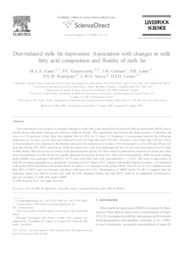Diet - inducet milk fat depression: Assoication with changes in milk fatty acid composition and fluidity of milk fat.
Diet - inducet milk fat depression: Assoication with changes in milk fatty acid composition and fluidity of milk fat.
Resumo: This experiment was designed to examine changes in milk fatty acids during fish oil-induced milk fat depression (MFD) and to test the theory that these changes are related to milk fat fluidity. The experiment was divided into three periods: 1) Baseline: all cows (n = 12) received a high fiber diet without fish oil (FO) for 12 days; 2) Treatment: 4 cows/group received the following treatments for 21 days: a) Low fiber diet without FO (LF), b) High fiber diet + FO (HF + FO) and c) Low fiber diet + FO (LF + FO); 3) Post-treatment: cows returned to the baseline diet and were monitored for 12 days. FO was included at 1.6% DM and HF and LF diets had 40 and 26% NDF, respectively. Milk fat content and yield were unchanged by the LF diet, but were reduced by FO diets at both dietary fiber levels and recovered in the post-treatment period. FO diets caused a pronounced reduction in stearic and oleic acid concentrations in milk fat and an equally pronounced increase in trans-18:1 fatty acid concentrations. Milk fat mean melting point (MMP) was correlated with MFD (r = 0.73) and with milk oleic acid concentration (r = ? 0.92). The ratio of oleic:stearic in milk fat increased gradually and consistently in response to FO. Trans-C18:1 isomers with double bounds at carbon ? 10 increased with greater MFD and those with double bonds at carbon ? 11 decreased with greater MFD. Trans-9 cis-11 CLA explained more than 80% of MFD and was strongly correlated with trans-10 C18:1. Maintenance of MMP below 39–40 °C suggests that the mammary gland was able to secrete only milk fat with adequate fluidity and that MFD could be an adaptation mechanism to prevent secretion of milk with higher MMP.
Ano de publicação: 2008
Tipo de publicação: Artigo de periódico
Unidade: Embrapa Gado de Leite
Palavras-chave: Conjugated linoleic acids, Fish oil, Milk fat depression, Milk fat fluidity, Trans-fatty acids
Observações
1 - Por padrão são exibidas publicações dos últimos 20 anos. Para encontrar publicações mais antigas, configure o filtro ano de publicação, colocando o ano a partir do qual você deseja encontrar publicações. O filtro está na coluna da esquerda na busca acima.
2 - Para ler algumas publicações da Embrapa (apenas as que estão em formato ePub), é necessário ter, no celular ou computador, um desses softwares gratuitos. Sistemas Android: Google Play Livros; IOS: iBooks; Windows e Linux: software Calibre.
Acesse outras publicações
Acesse a Base de Dados da Pesquisa Agropecuária (BDPA) para consultar o acervo completo das bibliotecas da Embrapa.

